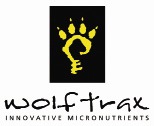New and improved ways to apply micronutrients help ensure growers' crops get the nutrients they need.
Wolf Trax founders Kerry Green and Geoff Gyles gave a boost to all growers when they developed Dry Dispersible Powder (DDP) Micronutrients in the 1990s. By combining common-sense thinking and scientific know-how, they created a line of products that established an entirely different class of micronutrients.
 Micronutrient fertilizers are an increasingly important component in maximizing crop production in America and across the world. Older granular micronutrient products made applications inefficient and often ineffective. Because micronutrients are needed in small amounts, their concentration in a fertilizer blend is tiny compared to macronutrients like nitrogen, phosphorus and potassium. When spread in a field with the fertilizer blend, the traditional granular micronutrients were sparsely distributed. Many plants could not then access the needed nutrient.
Micronutrient fertilizers are an increasingly important component in maximizing crop production in America and across the world. Older granular micronutrient products made applications inefficient and often ineffective. Because micronutrients are needed in small amounts, their concentration in a fertilizer blend is tiny compared to macronutrients like nitrogen, phosphorus and potassium. When spread in a field with the fertilizer blend, the traditional granular micronutrients were sparsely distributed. Many plants could not then access the needed nutrient.
Potato Micronutrients
Potatoes do require small amounts of various micronutrients. Some zinc is occasionally added. Boron on occasion may be added. And calcium is often added to improve tuber quality.
 Zinc is essential for synthesis of auxin, a key hormone-controlling cell growth. Deficiency results usually on alkaline soils or in the presence of excessive phosphorus. Symptoms include stunting, brown spots on stems and petioles and leaf malformation. Young leaves roll up as with Potato Leaf Roll virus and have a tip burn. The leaf roll is called "fern leaf," and is upward and cupping; leaves are also thick, brittle and puckered. Older leaves have gray-brown areas and bronzing along margins.
Zinc is essential for synthesis of auxin, a key hormone-controlling cell growth. Deficiency results usually on alkaline soils or in the presence of excessive phosphorus. Symptoms include stunting, brown spots on stems and petioles and leaf malformation. Young leaves roll up as with Potato Leaf Roll virus and have a tip burn. The leaf roll is called "fern leaf," and is upward and cupping; leaves are also thick, brittle and puckered. Older leaves have gray-brown areas and bronzing along margins.
The main boron deficiency symptom is bushiness. This results from death of the growing points and growth of lateral buds. Branching occurs due to loss of apical dominance. Leaves may exhibit leaf roll-like symptoms. Roots are short or stunted and thick.
Tubers are small with surface cracking. Localized brown areas appear under skin near stolon end. There's brown vascular discoloration.
Deficiency of calcium in potatoes is most severe in acidic, sandy soils. Vine symptoms include spindly stems and small, upward-rolling and crinkled leaflets. Tubers have vascular discoloration near the stolon end and flecks in the core. Severe deficiency causes extremely small tubers to form. In seed tubers, multiple lateral sprouts and internal sprouting may develop.
Deficiency in manganese is rare and occurs on alkaline calcareous soils. Young leaves (upper canopy) lack luster and are light green between the veins, which turn yellow and then white. Older, lower leaves are least affected. In severe deficiency, brown spots may appear along veins of younger leaves.
DDP Micronutrients
Green and Gyles developed DDP Micronutrients, which feature a patented, scientifically engineered coating technology formulated to coat and stick to each and every granule of macronutrient fertilizer in a blend. This results in even, blanket-like coverage of micronutrients across a field.
Wolf Trax's patented Dual Action Technology provides nutrients that are available immediately, as well as provide extended feeding over time.
When the advanced formulation of DDP Micronutrients and better distribution across a field are combined, the result is improved fertilizer access by the plant.
"DDP Micronutrients represent the first significant innovation in micronutrient technology in decades," says Wolf Trax Managing Director Green. "No other product resembles our technology."
"We are proud of where we have come and know there are still uses and applications for our patents that can contribute to helping growers farm more efficiently and effectively."
DDP technology ensures micronutrients are distributed throughout the root zone, providing many more interception points for roots to access micronutrients compared to traditional granular products.
Analyze Your Soil
It is imperative growers take advantage of soil analysis before any application of nutrients.
"Analyze each soil and work from there," says Jeff Baublits, Wolf Trax agronomist. "It's very essential so vitamins and nutrients are working at their optimum level."
Yet not every grower works with a certified crop advisor.
"That's a huge shortcoming," Baublits says. "You may have just wasted $1,000 because you didn't know the pH of your soil. You really need to get that soil test done."
Another useful tool for growers is variable-rate technology. Factors that influence crop productivity can be identified, mapped and used by computer software to provide an implemented solution. Field level precision opens the way to better manage variations where previously, in terms of treatments, a field was normally assumed to be homogeneous. Foliar-applied micronutrients can be used more efficiently.
Precision farming and variable-rate technologies use spatial databases within field environmental and management variables with the aim of equalizing the application of field inputs while maximizing production across the entire field.
"VRT is really fantastic," Baublits says. "That's the future of farming. You can really decrease costs in the long run. Decreasing the unit cost creates more profit because of less overhead."
When applied as a coating on granular, prilled fertilizer, Wolf Trax micronutrients are available to the crop the instant the crop accesses the nitrogen, phosphorus and potassium fertilizer. This represents a revolutionary leap ahead of old-style, granular products, where it can take weeks for the crop to "find" sparsely spread "chunks."
"DDP is very soluble," Baublits says. It works in both higher and lower pH soils.
With Wolf Trax DDP Micronutrients, root-to-nutrient contact is no longer left to chance.
DDP Micronutrients stay coated on the prills during blending, handling and application to the field. All fertilizer blends can be coated, including urea.
Baublits formerly worked as an agronomist for Grimmway Farms, overseeing 30,000 acres in California and Colorado.
In 2010, he said toxicity issues arose over chelated liquid nutrients in that year's potato crop.
"We switched to Wolf Trax, and it was a fantastic change. It was another positive tool for us to use. It really helped us change our program around."
The Future
As last year's drought across much of the United States aggressively attacked record yield projections, limiting crop loss by managing stress via micronutrient applications became an over-arching theme of the season.
Increased use of micronutrients is expected as growers proactively try to protect future yields against loss. In fact, more focus will be placed on avoiding yield loss rather than increasing yields.
Wolf Trax also predicts an increased demand for micros.
As commodity prices continue to trend upward, micronutrient use will likely continue to grow in prominence.
DDP formulations of zinc, boron, manganese, copper, iron and calcium were in high demand in 2011.
With the uncertainty in the market about supplies of granular zinc, Green says many dealers switched to the product line as a fertilizer coating. New customers liked how easily the DDP technology coated dry fertilizer when added to the blend-as well as the quality and consistency of the blend.
Wolf Trax is adding magnesium to its innovative DDP nutrient portfolio for the 2013 season. Magnesium DDP is designed to address magnesium deficiencies that growers may face in producing crops.
"Our customers have been asking for a better way to apply magnesium to crops. We are seeing significant early crop growth response to Magnesium DDP," Green says.